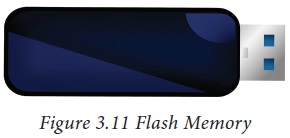Computer Organization - Secondary Storage Devices | 11th Computer Science : Chapter 3 : Computer Organization
Chapter: 11th Computer Science : Chapter 3 : Computer Organization
Secondary Storage Devices
Secondary Storage Devices
A computer generally has limited
amount of main memory which is expensive and volatile. To store data and
programs permanently, secondary storage devices are used. Secondary storage
devices serve as a supportive storage to main memory and they are non-volatile
in nature, secondary storage is also called as Backup storage
1. Hard Disks
Hard disk is a magnetic disk on
which you can store data. The hard disk has the stacked arrangement of disks
accessed by a pair of heads for each of the disks. The hard disks come with a
single or double sided disk.
2. Compact Disc (CD)
A CD or CD-ROM is made from 1.2
millimeters thick, polycarbonate plastic material. A thin layer of aluminum or
gold is applied to the surface. CD data is represented as tiny indentations
known as "pits", encoded in a spiral track moulded into the top of the
polycarbonate layer. The areas between pits are known as "lands". A
motor within the CD player rotates the disk. The capacity of an ordinary CD-ROM
is 700MB.

3. Digital Versatile Disc (DVD)
A DVD (Digital Versatile Disc or
Digital Video Disc) is an optical disc
capable of storing up to 4.7 GB of data, more than six times what a CD can
hold. DVDs are often used to store movies at a better quality. Like CDs, DVDs
are read with a laser.
The disc can have one or two
sides, and one or two layers of data per side; the number of sides and layers
determines how much it can hold. A 12 cm diameter disc with single sided,
single layer has 4.7 GB capacity, whereas the single sided, double layer has
8.5 GB capacity. The 8 cm DVD has 1.5 GB capacity. The capacity of a DVD-ROM
can be visually determined by noting the number of data sides of the disc.
Double-layered sides are usually gold-coloured, while single-layered sides are
usually silver-coloured, like a CD.

4. Flash Memory Devices
Flash memory is an electronic
(solid-state) non-volatile computer storage medium that can be electrically erased and reprogrammed.
They are either EEPROM or EPROM. Examples for Flash memories are pendrives,
memory cards etc. Flash memories can be used in personal computers, Personal
Digital Assistants (PDA), digital audio players, digital cameras and mobile
phones. Flash memory offers fast access times. The time taken to read or write
a character in memory is called access time. The capacity of the flash memories
vary from 1 Gigabytes (GB) to 2 Terabytes (TB). A sample of flash memory is
shown in Figure 3.11.

5. Blu-Ray Disc
Blu-Ray Disc is a
high-density optical disc similar to DVD. Blu-ray is the type of disc used for
PlayStation games and for playing High-Definition (HD) movies.
A double-layer Blu-Ray
disc can store up to 50GB (gigabytes) of data. This is more than 5 times the
capacity of a DVD, and above 70 times of a CD. The format was developed to
enable recording, rewriting and playback of high-definition video, as well as
storing large amount of data. DVD uses a red laser to read and write data. But,
Blu-ray uses a blue-violet laser to write. Hence, it is called as Blu-Ray.

Related Topics